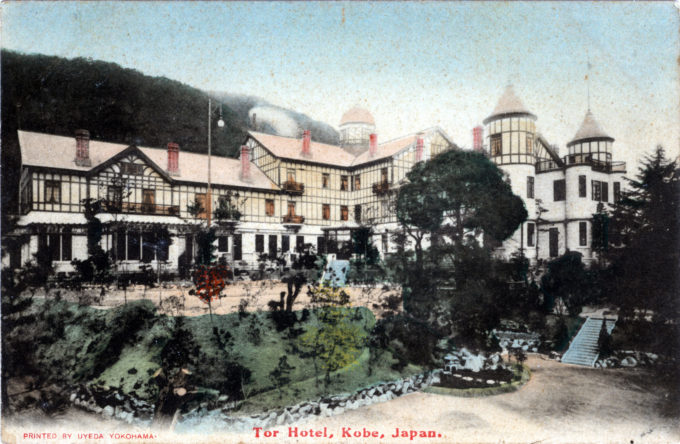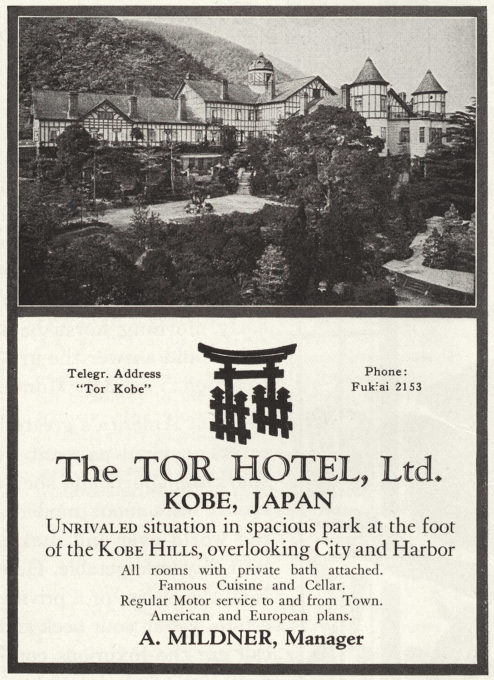See also:
Oriental Hotel, Kobe, c. 1910
American Hatoba (Wharf), Kobe, c. 1910
“Tor Kobe, a new modern hotel with 70 rooms, each with a bath room, and accommodations for 100 guests, stands in the midst of fine grounds backed by pine woods at the foot of Suwayama on Yamamoto-dori at the top of Naka-yamate-dori. Good air, magnificent views, English and German spoken. Rates from ¥7 a day and upward. American plan(*). Good food. Naval and Army men and their families from ¥6 and upward. Reduction for a long stay. Garage; motor cars.”
– Terry’s Japanese Empire, T. Philip Terry, 1914
(* “American plan”: a system of paying a single daily rate that covers the room and all meals.)
The Tor Hotel was constructed in 1907 and decorated in the style of a Swiss chalet by Alfred Mildner, a German hotelier born in Alcase Lorraine, because the popular Oriental Hotel near the port was overcrowded each time passenger ships arrived. It catered to visiting dignitaries and tourists as well as wealthy Japanese and foreign residents. The hotel received its name from it location, tor, a Cornish word for ‘rocky hill’. Soon people started to call the road leading to it ‘Tor Road’. The hotel was located on the northern end of Tor Road, near the present-day location of the Kobe Club.
The Tor Hotel burned down in 1950, and little now remains of the earlier history of the site except for the giant Himalayan cedars in the front car park, thought to have been planted around 1890 by Arthur Greppi, a European businessman who had lived on the site before the hotel opened in 1908. There is also one small, red torii gate – all that remains of an Inari shrine that was located in the hotel garden and had several torii leading to it.
“I don’t think I was a capricious or spoiled child, although I recall being very well taken care of at the Tor Hotel in Kobe, Japan. Father Alfred [Alfred Mildner] owned this hotel, and my arrival there, at the age of one, took place in late 1940 after a somewhat circuitous journey from France to Shanghai, China where my mother and father Edouard had taken me.
“… It was a grand hotel, even when compared to some of the luxury hotels of today. It was built in the Swiss Chalet style and had close to 100 suites, which in the thirties and early forties ranked it among the finest hotels. The grand ballroom was spectacular, with teak parquet flooring, many crystal chandeliers, and a large band-stand or stage that could be converted to suit the occasion.
“… The only time I ever saw [Father Alfred] lose his poise was in 1945 after the war had just ended, and his beloved Tor Hotel had been taken over by the Americans and converted into an officers club. It seems that after a large party [in 1950] a fire had started in one of the rooms and it burned to the ground. On that day he cried. He later told me how ironic it was that this world-class grand hotel, having survived the fires of war, had to burn down as the result of a drunken party. He had designed the hotel, had supervised its construction, and to him it had been a labor of love.”
– Before It’s Too Late: My Life and My Recollections, by George Clark, 2013








